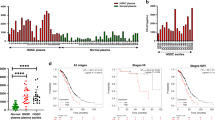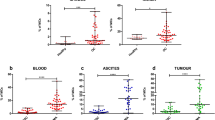Abstract
Background
Ovarian cancer (OC) as the most fatal gynecological malignancy worldwide, with epithelial ovarian cancer (EOC) being the predominant and most lethal form, poses a serious threat to human health. LC3-positive extracellular vesicles (LC3+ EVs) promote tumorigenesis by educating CD4+ T cells in a murine melanoma model. However, regulation of LC3+ EVs in human EOC remains largely unknown.
Methods
Differential analysis of Rab8a, Hsp90α and Il6 expression was performed using GEPIA2. The number of LC3+ EVs and the frequency of Heat shock protein 90α+ LC3+ EVs (HSP90α+ LC3+ EVs) in the ascites of EOC patients were tested by flow cytometry. IL-6, IL-10, IFN-γ, IL-4 and TGF-β were measured by ELISA. CD4+ T cells were isolated from peripheral blood of healthy human donors using MACS magnetic bead technology.
Results
Higher Rab8a, Hsp90a and Il6 expression of cancer tissues compared with normal adjacent tissues in OC were found. The level of IL-6 was positively correlated with LC3+ EVs number, HSP90α+ LC3+ EVs percentage in the ascites, and ROMA index of the patient. In addition, elevated IL-6 production by CD4+ T cells induced by LC3+ EVs was observed, which was suppressed by anti-HSP90α or anti-TLR2.
Conclusions
LC3+ EVs level and HSP90α+ LC3+ EVs percentage were associated with elevated IL-6 in the ascites of EOC patients. HSP90α on LC3+ EVs from human EOC could stimulate CD4+ T cell production of IL-6 via TLR2.




Similar content being viewed by others
Abbreviations
- LC3+ EVs:
-
LC3-positive extracellular vesicles
- HSP90α:
-
Heat shock protein 90α
- EOC:
-
Epithelial ovarian cancer
- DAMPs:
-
Damage-associated molecular pattern molecules
- DFS:
-
Disease-free survival
- PFS:
-
Progression-free survival
- OS:
-
Overall survival
References
Ferlay J, Soerjomataram I, Dikshit R, Eser S, Mathers C, Rebelo M, et al. Cancer incidence and mortality worldwide: sources, methods and major patterns in GLOBOCAN 2012. Int J Cancer. 2015;136(5):E359–86. https://doi.org/10.1002/ijc.29210.
Vargas-Hernandez VM, Moreno-Eutimio MA, Acosta-Altamirano G, Vargas-Aguilar VM. Management of recurrent epithelial ovarian cancer. Gland Surg. 2014;3(3):198–202. https://doi.org/10.3978/j.issn.2227-684X.2013.10.01.
Bray F, Ferlay J, Soerjomataram I, Siegel RL, Torre LA, Jemal A. Global cancer statistics 2018: GLOBOCAN estimates of incidence and mortality worldwide for 36 cancers in 185 countries. CA Cancer J Clin. 2018;68(6):394–424. https://doi.org/10.3322/caac.21492.
Del CJ, Matulonis UA, Malander S, Provencher D, Mahner S, Follana P, et al. Niraparib maintenance therapy in patients with recurrent ovarian cancer after a partial response to the last platinum-based chemotherapy in the ENGOT-OV16/NOVA trial. J Clin Oncol. 2019;37(32):2968–73. https://doi.org/10.1200/JCO.18.02238.
Van Gorp T, Cadron I, Despierre E, Daemen A, Leunen K, Amant F, et al. HE4 and CA125 as a diagnostic test in ovarian cancer: prospective validation of the risk of ovarian malignancy algorithm. Br J Cancer. 2011;104(5):863–70. https://doi.org/10.1038/sj.bjc.6606092.
DuPage M, Bluestone JA. Harnessing the plasticity of CD4(+) T cells to treat immune-mediated disease. Nat Rev Immunol. 2016;16(3):149–63. https://doi.org/10.1038/nri.2015.18.
Borst J, Ahrends T, Babala N, Melief C, Kastenmuller W. CD4(+) T cell help in cancer immunology and immunotherapy. Nat Rev Immunol. 2018;18(10):635–47. https://doi.org/10.1038/s41577-018-0044-0.
Jiang S, Dupont N, Castillo EF, Deretic V. Secretory versus degradative autophagy: unconventional secretion of inflammatory mediators. J Innate Immun. 2013;5(5):471–9. https://doi.org/10.1159/000346707.
Yin Z, Liu X, Ariosa A, Huang H, Jin M, Karbstein K, et al. Psp2, a novel regulator of autophagy that promotes autophagy-related protein translation. Cell Res. 2019;29(12):994–1008. https://doi.org/10.1038/s41422-019-0246-4.
Mutsafi Y, Altan-Bonnet N. Enterovirus transmission by secretory autophagy. Viruses. 2018;10(3):139. https://doi.org/10.3390/v10030139.
Son SM, Cha MY, Choi H, Kang S, Choi H, Lee MS, et al. Insulin-degrading enzyme secretion from astrocytes is mediated by an autophagy-based unconventional secretory pathway in Alzheimer disease. Autophagy. 2016;12(5):784–800.
Yang Y, Qin M, Bao P, Xu W, Xu J. Secretory carrier membrane protein 5 is an autophagy inhibitor that promotes the secretion of alpha-synuclein via exosome. PLoS ONE. 2017;12(7): e180892. https://doi.org/10.1371/journal.pone.0180892.
Gonzalez CD, Resnik R, Vaccaro MI. Secretory autophagy and its relevance in metabolic and degenerative disease. Front Endocrinol (Lausanne). 2020;11:266. https://doi.org/10.3389/fendo.2020.00266.
Son SM, Kang S, Choi H, Mook-Jung I. Statins induce insulin-degrading enzyme secretion from astrocytes via an autophagy-based unconventional secretory pathway. Mol Neurodegener. 2015;10:56. https://doi.org/10.1186/s13024-015-0054-3.
Padmanabhan S, Manjithaya R. Facets of autophagy based unconventional protein secretion-the road less traveled. Front Mol Biosci. 2020;7: 586483. https://doi.org/10.3389/fmolb.2020.586483.
Li Y, Wang LX, Pang P, Cui Z, Aung S, Haley D, et al. Tumor-derived autophagosome vaccine: mechanism of cross-presentation and therapeutic efficacy. Clin Cancer Res. 2011;17(22):7047–57. https://doi.org/10.1158/1078-0432.CCR-11-0951.
Zhou M, Wen Z, Cheng F, Ma J, Li W, Ren H, et al. Tumor-released autophagosomes induce IL-10-producing B cells with suppressive activity on T lymphocytes via TLR2-MyD88-NF-kappaB signal pathway. Oncoimmunology. 2016;5(7): e1180485. https://doi.org/10.1080/2162402X.2016.1180485.
Chen YQ, Li PC, Pan N, Gao R, Wen ZF, Zhang TY, et al. Tumor-released autophagosomes induces CD4(+) T cell-mediated immunosuppression via a TLR2-IL-6 cascade. J Immunother Cancer. 2019;7(1):178. https://doi.org/10.1186/s40425-019-0646-5.
Crispim P, Jammal MP, Antao P, Micheli DC, Tavares-Murta BM, Murta E, et al. IL6, IL8, and IL10 in the distinction of malignant ovarian neoplasms and endometriomas. Am J Reprod Immunol. 2020;84(6): e13309. https://doi.org/10.1111/aji.13309.
Narayan V, Thompson EW, Demissei B, Ho JE, Januzzi JJ, Ky B. Mechanistic biomarkers informative of both cancer and cardiovascular disease: JACC state-of-the-art review. J Am Coll Cardiol. 2020;75(21):2726–37. https://doi.org/10.1016/j.jacc.2020.03.067.
Johnson DE, O’Keefe RA, Grandis JR. Targeting the IL-6/JAK/STAT3 signalling axis in cancer. Nat Rev Clin Oncol. 2018;15(4):234–48. https://doi.org/10.1038/nrclinonc.2018.8.
Wang ZY, Zhang JA, Wu XJ, Liang YF, Lu YB, Gao YC, et al. IL-6 Inhibition reduces stat3 activation and enhances the antitumor effect of carboplatin. Mediators Inflamm. 2016;2016:8026494. https://doi.org/10.1155/2016/8026494.
Browning L, Patel MR, Horvath EB, Tawara K, Jorcyk CL. IL-6 and ovarian cancer: inflammatory cytokines in promotion of metastasis. Cancer Manag Res. 2018;10:6685–93. https://doi.org/10.2147/CMAR.S179189.
de Lima CA, Silva RI, Martins-Filho A, Cobo MD, Martins TB, Candido ME, et al. Cytokines in peritoneal fluid of ovarian neoplasms. J Obstet Gynaecol. 2020;40(3):401–5. https://doi.org/10.1080/01443615.2019.1633516.
Rodrigues I, Martins-Filho A, Micheli DC, Lima CA, Tavares-Murta BM, Murta E, et al. IL-6 and IL-8 as Prognostic Factors in Peritoneal Fluid of Ovarian Cancer. Immunol Invest. 2020;49(5):510–21. https://doi.org/10.1080/08820139.2019.1691222.
Kampan NC, Madondo MT, Reynolds J, Hallo J, McNally OM, Jobling TW, et al. Pre-operative sera interleukin-6 in the diagnosis of high-grade serous ovarian cancer. Sci Rep. 2020;10(1):2213. https://doi.org/10.1038/s41598-020-59009-z.
Wen ZF, Liu H, Gao R, Zhou M, Ma J, Zhang Y, et al. Tumor cell-released autophagosomes (TRAPs) promote immunosuppression through induction of M2-like macrophages with increased expression of PD-L1. J Immunother Cancer. 2018;6(1):151. https://doi.org/10.1186/s40425-018-0452-5.
Wang YC, Wu YS, Hung CY, Wang SA, Young MJ, Hsu TI, et al. USP24 induces IL-6 in tumor-associated microenvironment by stabilizing p300 and beta-TrCP and promotes cancer malignancy. Nat Commun. 2018;9(1):3996. https://doi.org/10.1038/s41467-018-06178-1.
Wu Z, Geng Y, Lu X, Shi Y, Wu G, Zhang M, et al. Chaperone-mediated autophagy is involved in the execution of ferroptosis. Proc Natl Acad Sci U S A. 2019;116(8):2996–3005. https://doi.org/10.1073/pnas.1819728116.
Chen CC, Chen LL, Li CP, Hsu YT, Jiang SS, Fan CS, et al. Myeloid-derived macrophages and secreted HSP90alpha induce pancreatic ductal adenocarcinoma development. Oncoimmunology. 2018;7(5): e1424612. https://doi.org/10.1080/2162402X.2018.1424612.
Chen WS, Chen CC, Chen LL, Lee CC, Huang TS. Secreted heat shock protein 90alpha (HSP90alpha) induces nuclear factor-kappaB-mediated TCF12 protein expression to down-regulate E-cadherin and to enhance colorectal cancer cell migration and invasion. J Biol Chem. 2013;288(13):9001–10. https://doi.org/10.1074/jbc.M112.437897.
Gao R, Ma J, Wen Z, Yang P, Zhao J, Xue M, et al. Tumor cell-released autophagosomes (TRAP) enhance apoptosis and immunosuppressive functions of neutrophils. Oncoimmunology. 2018;7(6): e1438108. https://doi.org/10.1080/2162402X.2018.1438108.
Funding
We are grateful for the support from grants from the National Natural Science Foundation of China [NO. 8187101983], and Maternal and Child Health Research Project of Jiangsu Province [F201923].
Author information
Authors and Affiliations
Contributions
YLC, NP and HJW designed this study. XLZ and XRW performed the experiments. XLZ and HJW wrote the manuscript, performed the literature search. DW, XJ, LX, QY, JYG, and YR collected the clinical data and helped write the manuscript. YLC and NP were responsible for manuscript revision. All the authors read and approved the final manuscript.
Corresponding authors
Ethics declarations
Conflict of interest
The authors declare that they have no conflict of interest
Ethics approval
All the human experiments were approved by the Ethics Committee for Human Studies of Southeast University and performed under protocol 2019ZDSYLL021.
Informed consent
Informed consent was obtained from all the patients
Additional information
Publisher's Note
Springer Nature remains neutral with regard to jurisdictional claims in published maps and institutional affiliations.
Supplementary Information
Below is the link to the electronic supplementary material.
Rights and permissions
About this article
Cite this article
Zhu, XL., Wang, HJ., Wang, XR. et al. IL-6 secretion of CD4+ T cells stimulated by LC3-positive extracellular vesicles in human epithelial ovarian cancer. Clin Transl Oncol 24, 2222–2230 (2022). https://doi.org/10.1007/s12094-022-02883-y
Received:
Accepted:
Published:
Issue Date:
DOI: https://doi.org/10.1007/s12094-022-02883-y




